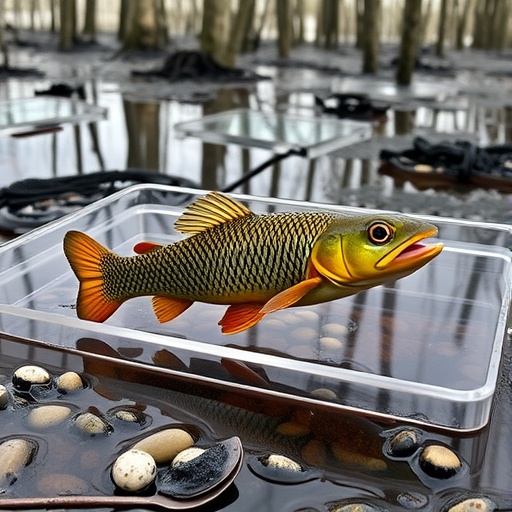Unprecedented Survival: How Fish and Amphibians Adapt After Megafires
In a groundbreaking study published in Communications Earth and Environment, researchers have uncovered a remarkable ecological response from fish and amphibians in the wake of megafires that devastate watersheds. This research indicates that, contrary to previous assumptions about the deleterious effects of severe environmental damage, aquatic life can exhibit surprising resilience in seemingly inhospitable conditions. The study offers fresh insights into biodiversity and the tenacity of life, emphasizing that nature can often rebound in unforeseen ways.
The intricate relationship between fire and aquatic ecosystems has long been underestimated. When megafires sweep through a landscape, the immediate aftermath may appear apocalyptic — scorched earth, charred vegetation, and significant alterations to water quality. However, the study led by Swartz et al. reveals an unexpected narrative: fishes can thrive and amphibians can endure in these harsh, transformed environments. This phenomenon raises questions about adaptability, ecological balance, and the overall resilience of ecosystems facing climate change-driven wildfires.
The research team meticulously studied multiple watersheds that experienced severe burns due to megafires. They collected data on fish populations, amphibian presence, and water quality variables post-fire. Their findings suggest that certain fish species capitalize on the new opportunities presented by altered habitats, such as increased nutrient influx from ash runoff following fires. This nutrient enhancement can lead to prolific growth and reproductive success in aquatic species that thrive on the input of organic materials washed into streams and rivers.
Amphibians, often regarded as sensitive indicators of environmental health, showed unexpected persistence in these burned watersheds. The resilience of amphibian populations post-fire is particularly intriguing. The study suggests that while some individuals may perish due to immediate habitat destruction, others may survive and even flourish due to reduced competition and predation in fire-altered environments. The research underscores the complexities of survival strategies utilized by amphibians, highlighting their ability to adapt to drastic changes.
In analyzing water quality, the researchers noticed fluctuations in pH and turbidity levels in the aftermath of the fires. Although initially, these changes suggested a harsh environment for aquatic life, over time, organic matter accumulation from the fire’s aftermath positively influenced the biological community. This finding is crucial in understanding how fires can paradoxically lead to the rebirth of ecosystems in the long term rather than a simple death sentence.
The implications of this study extend beyond just fish and amphibians. The resilience observed prompts a re-evaluation of biodiversity conservation strategies in landscapes prone to fire. It challenges the prevailing notion that all disturbances are harmful, particularly in the context of climate change. As wildfires become increasingly frequent and severe, understanding how different species respond to such disturbances could offer critical knowledge for conservationists and environmental planners.
Moreover, the adaptability of fish and amphibians in the wake of megafires poses questions about the evolutionary pressures these species face. Researchers speculate that the capacity to rebound from catastrophic events may shape the adaptive traits of these organisms in ways that promote survival in fluctuating environments. The study raises important discussions on the evolutionary trajectories of species subjected to such intense natural selection pressures.
Furthermore, the research indicated a potential shift in species dominance within affected watersheds. While some species may flourish after fires, others may struggle or even decline, leading to an altered ecological landscape. This highlights the importance of monitoring post-fire recovery dynamics, providing crucial insights into species interactions and community structure long after the flames have been extinguished.
Public awareness of the ecological impacts of megafires is essential as climate change continues to alter precipitation patterns and increase the likelihood of wildfires. By understanding that some species may actually thrive, this research could shift public perception of megafires from purely destructive phenomena to significant ecological events that can foster resilience and biodiversity under the right conditions.
Educators and communicators can utilize these findings to promote broader discussions around fire ecology. Engaging communities in understanding the dual nature of fires, both destructive and regenerative, provides an essential perspective on how ecosystems function and adapt. As the frequency of megafires rises, fostering an informed public will be key to developing constructive management strategies that harmonize human activity with natural processes.
For policy-makers, these insights emphasize the need to incorporate ecological resilience into land management practices. Understanding that fires can serve as catalysts for renewal can guide strategic planning efforts that protect both human interests and ecological health, enabling wiser land-use decisions that recognize the complexities of fire-influenced environments.
In conclusion, the findings presented by Swartz and colleagues offer a fresh perspective on the nature of resilience in aquatic ecosystems following megafires. Their research illustrates that fires, while devastating, can also catalyze processes that allow for the endurance and flourishing of life in unexpected ways. This highlights the profound adaptability of species like fish and amphibians, suggesting that nature’s ability to recover can serve as a beacon of hope amid the challenges posed by climate change.
As the world grapples with increasing environmental challenges, studies like this shine a light on the remarkable resilience found in nature, urging both a re-evaluation of ecological concepts and a renewed commitment to supporting biodiversity in all its forms.
Subject of Research: Ecological responses of fish and amphibians following megafires in watersheds.
Article Title: Following megafires fishes thrive and amphibians persist even in severely burned watersheds.
Article References: Swartz, A.G., Coble, A.A., Penaluna, B.E. et al. Following megafires fishes thrive and amphibians persist even in severely burned watersheds. Commun Earth Environ 6, 945 (2025). https://doi.org/10.1038/s43247-025-02893-y
Image Credits: AI Generated
DOI: https://doi.org/10.1038/s43247-025-02893-y
Keywords: megafires, fish, amphibians, resilience, ecosystems, biodiversity, climate change, fire ecology.




